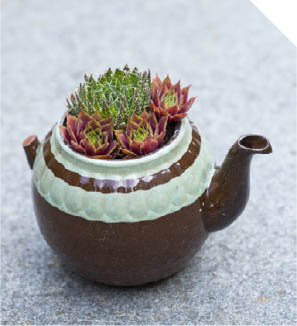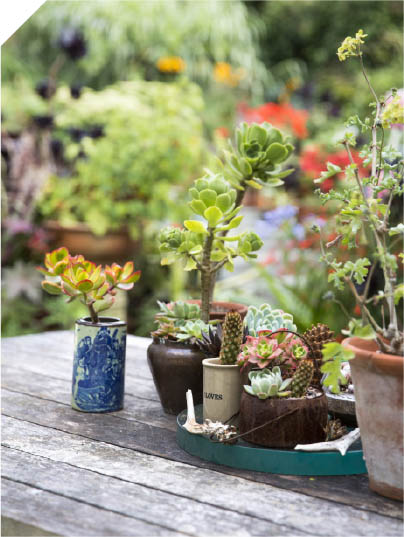
Generally, containers sit on the ground or on a hard surface, but don’t forget that there is also the option of using wall-mounted or hanging pots. Wherever you put your containers, when choosing your pots, you need to think carefully about what you will use in relation to where they will be situated.
The keys to choosing the right container for a specific place are its weight and size. For a container that sits on the ground in a permanent position, there are more options, simply because the combined weight of the pot and the soil is not an issue. On the ground, you can create small, dainty arrangements with several little pots gathered together, or you can use huge raised beds, troughs, urns, or any other really large containers.
If you want to put your container on the floor of a balcony or roof terrace, you need to weigh the options more carefully. A fully finished and watered container is not a lightweight feature—the water alone can weigh a lot (1 liter weighs 2.2 pounds [1 kg]), and when it is added to a heavy pot filled with soil . . . you get the picture. The last thing you want to do is overburden your balcony or roof terrace with weighty items; this can be very dangerous if the area can’t take the load. However, one way of getting around this is by reducing the amount of heavy soil in a container and bulking it up with lightweight polystyrene or something similar. Don’t use too much—just enough to make the containers a little less hefty. If you are thinking about a shelf or other wall-mounted system, keep in mind that you will need even lighter loads and smaller pots.

An upcycled metal container makes a bold, modern feature, creating an innovative boundary. When softened with a planting scheme of Eupatorium and grasses, it looks more rustic.
BIG CONTAINERS
Containers come in all shapes and sizes. I have two large containers in my front yard in the form of raised beds. This is partly because I cannot grow much in the soil as it is mainly sand, and, because I live near the sea, it has a very high salt content. It also doesn’t drain very well (unusual for a sandy soil—lucky me!), so I had no choice but to make two giant containers and fill them with better soil in which I actually have a chance of growing healthy plants.
Many gardeners face the same problems. It could be for all sorts of reasons—maybe you have unstable ground, inhospitable ground, trouble bending down to work at a low level, a solid concrete patio that you don’t want to break up, or a problem with damp soil, or maybe you just like the look of raised beds as opposed to borders dug into the ground. You can get around these issues by building a container to fit your space and serve your needs, and it can be as big as you like or as big as looks right in your space. It can also have the bonus of doubling as a seat or storage with a bit of creative design.
Single species make a bold statement. This huge pot is planted with one of the biggest herbaceous perennials: Gunnera macrophylla.
But for those who do not enjoy building, there are all kinds of large containers available. They can be purpose-built containers (urns being a classic example) or something more contemporary, made of modern materials like concrete or rusted steel. They can also be something not originally intended to house plants but cleverly repurposed to do just that. I have even heard of cars being turned into huge containers with plants spilling out of the trunks, hoods, and windows. If you have the space, and you love to grow, then a large container does the best job of simulating the ground because it allows plenty of root space and nutrients. You can either grow a lot more of the plants you love or fewer mature, large specimens. A big container also makes a bold statement—something that, if you have the courage, can be the foundation of an outdoor space, even a small one.
A collection of simple, small pots is a very effective way of filling a pint-sized patch. By using all kinds of varying textures, you can create something eclectic, subtle, and undeniably beautiful, belying your space’s diminutive beginnings.
If you only have limited space, don’t despair—there is a vast array of containers you can use, as small as you like. There are all sorts of weird and wonderful ideas out there for making containers out of almost any material. The key consideration when using really small containers is the planting because you need to choose species that can cope with having their roots very restricted. The soil in a small container also tends to dry out and lose its nutrients quicker than that in a large pot. So unless you have a lot of time and love to give your containers, it’s worth choosing fairly low-maintenance plants that can cope with dry, nutrient-poor, small spaces, or plants that are extremely slow growing. Plants such as geraniums, sedums, and other succulents; Erigeron and other wild daisies, and even many herbs such as lavender, thyme, and rosemary can cope with slightly drier, nutrient-poor conditions and, dare I say, neglect from us growers!
As a rule (and a hard-and-fast one at that), a plant whose roots are restricted will grow slowly. Generally, in containers and in the ground, what’s going on above the soil directly correlates with what’s going on below. So when the roots are unable to spread and grow, the stems and leaves will be likewise reduced. This is how the Japanese tradition of bonsai works; when the roots of a tree that would ordinarily be several stories tall has its growth restricted, the trunk, branches, and leaves are much smaller than they would be in the wild. Be warned that these trees do still need nutrients and a fair amount of water and thus are pretty high maintenance. However, for those with the time to dedicate to their bonsai (and my dad is someone who puts his all into his collection), a tree can be lovingly nurtured to grow for hundreds of years in one small pot and never grow taller than a few feet (see page 123).


This array of succulent plants in various small containers proves that there are no limits to the choices available to you with clever use of plants. Don’t feel limited by these resilient plant species: their shapes and colors can be as varied as the receptacles in which they’re planted.